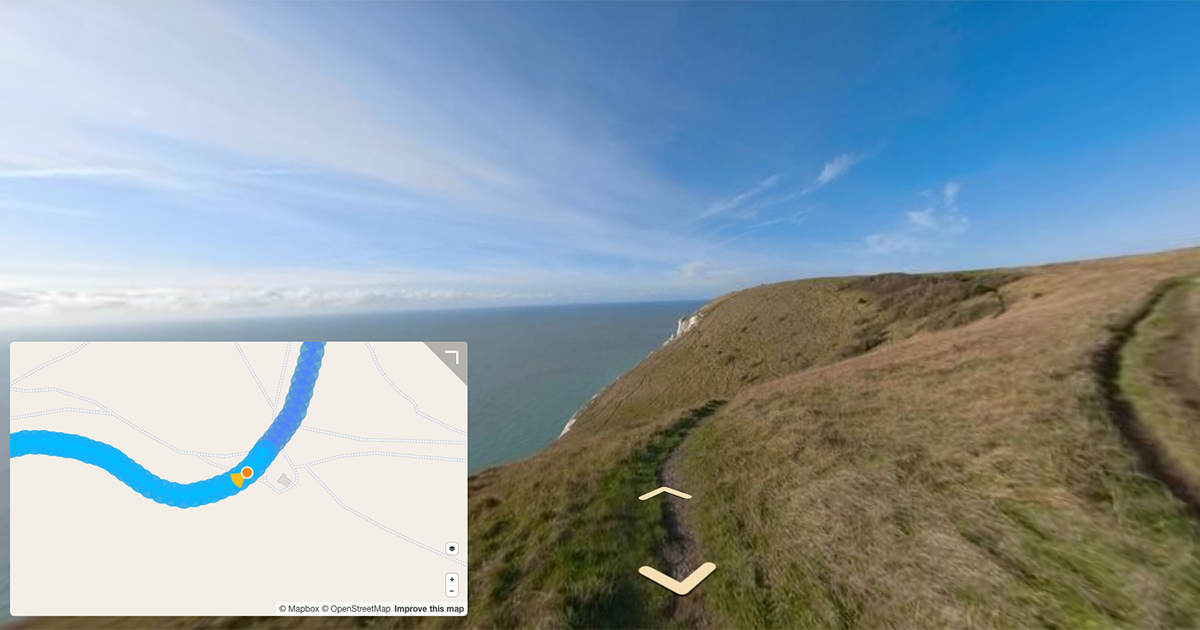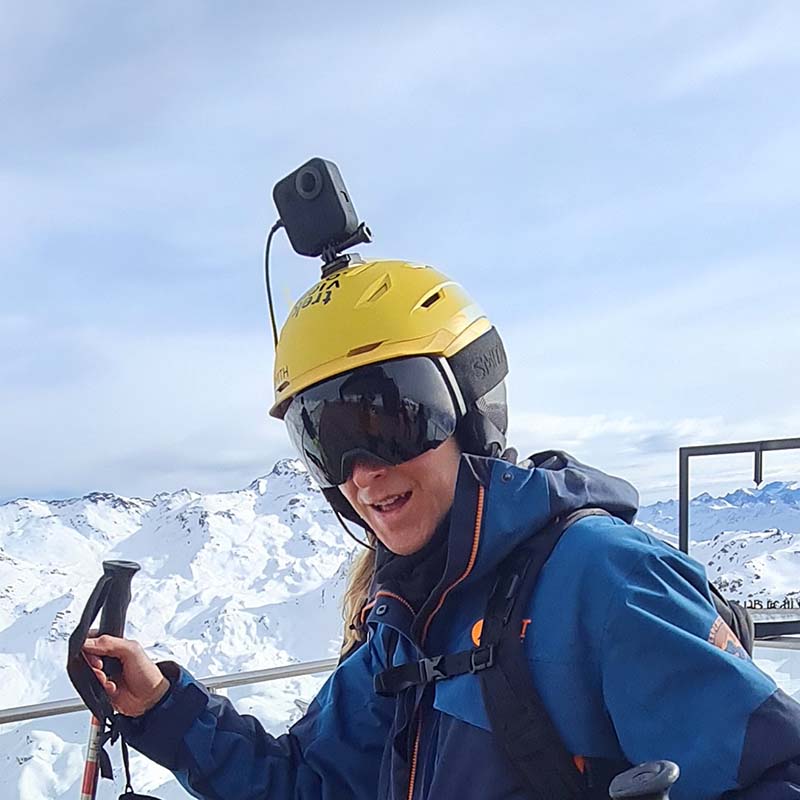A lesson, mostly, in wrangling metadata to ensure proper playback of 360 videos created from a series of photos.
In previous posts I’ve covered, turning 360 videos into a series of timelapse images (part 1 and part 2)
You might also want to do the reverse; turn photos into a 360 video.
In this post I want to outline the process of turning your timelapse 360 photo’s into a 360 video and some of the additional considerations to be aware of for playback.
1. Preparation
For this guide I’ll be using ffmpeg, a free and open-source project consisting of a vast software suite of libraries and programs for handling video, audio, and other multimedia files and streams.
You’ll also need EXIFtool to write metadata (e.g. ProjectionType) into the resulting video.
As exiftool cannot write in XMP-GSpherical tags (more on that later), you’ll also need a copy of this set of scripts (Spatial Media Metadata Injector) from Google on your machine.
I’ll use a series of 55 timelapse photos shot using a GoPro Fusion at 5 second intervals and stitched as .jpg files at 5.8K. Grab them here if you want to follow along.
Of course, you are free to use your own timelapse photos too.
If you choose to use your own images, be aware this post assumes your images are:
- in sequential ascending order by filename (e.g. MULTISHOT_9698_000000.jpg, MULTISHOT_9698_000001.jpg, MULTISHOT_9698_000002.jpg, etc.)
- all placed in a single directory containing only images you want in the video
2. Create the video
Now we can create a video called demo-video-no-meta.mp4 using all the images in the directory:
$ ffmpeg -r 1 -i MULTISHOT_9698_%06d.jpg -c:v libx264 -pix_fmt yuv420p demo-video-no-meta.mp4
Let’s break that down:
-i MULTISHOT_9698_%06d.jpg: the filenames to match on.%06dmeans capture 6 digits.%03dwould mean capture 3 digits.-r 1: the output framerate per second. Here I want 1 frame every 1 second. If the-roption is omitted the default will input and output 25 frames per second.-pix_fmt yuv420p: When outputting H.264, adding -vf format=yuv420p or -pix_fmt yuv420p will ensure compatibility so crappy players can decode the video.-c:v libx264is an abbreviated version of codec:v. Encodes the video using the libx264 codec (H264).
The video is looking good. There are 55 images in my sequence and the video is 55 seconds long. However, it’s not showing as a 360 video… yet.
3. Add the required metadata
As I talked about last year, video files, and specifically 360 video files, hold metadata that is important for video players to render and display the video correctly.
Looking at the metadata of the video I just created using exiftool:
$ exiftool -X demo-video-no-meta.mp4 > demo-video-no-meta-metadata.xml
Gives a .xml file with the contents:
<?xml version='1.0' encoding='UTF-8'?>
<rdf:RDF xmlns:rdf='http://www.w3.org/1999/02/22-rdf-syntax-ns#'>
<rdf:Description rdf:about='demo-video-no-meta.mp4'
xmlns:et='http://ns.exiftool.ca/1.0/' et:toolkit='Image::ExifTool 12.10'
xmlns:ExifTool='http://ns.exiftool.ca/ExifTool/1.0/'
xmlns:System='http://ns.exiftool.ca/File/System/1.0/'
xmlns:File='http://ns.exiftool.ca/File/1.0/'
xmlns:QuickTime='http://ns.exiftool.ca/QuickTime/QuickTime/1.0/'
xmlns:Track1='http://ns.exiftool.ca/QuickTime/Track1/1.0/'
xmlns:ItemList='http://ns.exiftool.ca/QuickTime/ItemList/1.0/'
xmlns:Composite='http://ns.exiftool.ca/Composite/1.0/'>
<ExifTool:ExifToolVersion>12.10</ExifTool:ExifToolVersion>
<System:FileName>demo-video-no-meta.mp4</System:FileName>
<System:Directory>.</System:Directory>
<System:FileSize>119 MB</System:FileSize>
<System:FileModifyDate>2021:07:31 20:50:06+01:00</System:FileModifyDate>
<System:FileAccessDate>2021:07:31 20:49:05+01:00</System:FileAccessDate>
<System:FileInodeChangeDate>2021:07:31 20:50:06+01:00</System:FileInodeChangeDate>
<System:FilePermissions>rw-r--r--</System:FilePermissions>
<File:FileType>MP4</File:FileType>
<File:FileTypeExtension>mp4</File:FileTypeExtension>
<File:MIMEType>video/mp4</File:MIMEType>
<QuickTime:MajorBrand>MP4 Base Media v1 [IS0 14496-12:2003]</QuickTime:MajorBrand>
<QuickTime:MinorVersion>0.2.0</QuickTime:MinorVersion>
<QuickTime:CompatibleBrands>
<rdf:Bag>
<rdf:li>isom</rdf:li>
<rdf:li>iso2</rdf:li>
<rdf:li>avc1</rdf:li>
<rdf:li>mp41</rdf:li>
</rdf:Bag>
</QuickTime:CompatibleBrands>
<QuickTime:MediaDataSize>124504510</QuickTime:MediaDataSize>
<QuickTime:MediaDataOffset>48</QuickTime:MediaDataOffset>
<QuickTime:MovieHeaderVersion>0</QuickTime:MovieHeaderVersion>
<QuickTime:CreateDate>0000:00:00 00:00:00</QuickTime:CreateDate>
<QuickTime:ModifyDate>0000:00:00 00:00:00</QuickTime:ModifyDate>
<QuickTime:TimeScale>1000</QuickTime:TimeScale>
<QuickTime:Duration>0:00:55</QuickTime:Duration>
<QuickTime:PreferredRate>1</QuickTime:PreferredRate>
<QuickTime:PreferredVolume>100.00%</QuickTime:PreferredVolume>
<QuickTime:MatrixStructure>1 0 0 0 1 0 0 0 1</QuickTime:MatrixStructure>
<QuickTime:PreviewTime>0 s</QuickTime:PreviewTime>
<QuickTime:PreviewDuration>0 s</QuickTime:PreviewDuration>
<QuickTime:PosterTime>0 s</QuickTime:PosterTime>
<QuickTime:SelectionTime>0 s</QuickTime:SelectionTime>
<QuickTime:SelectionDuration>0 s</QuickTime:SelectionDuration>
<QuickTime:CurrentTime>0 s</QuickTime:CurrentTime>
<QuickTime:NextTrackID>2</QuickTime:NextTrackID>
<QuickTime:HandlerType>Metadata</QuickTime:HandlerType>
<QuickTime:HandlerVendorID>Apple</QuickTime:HandlerVendorID>
<Track1:TrackHeaderVersion>0</Track1:TrackHeaderVersion>
<Track1:TrackCreateDate>0000:00:00 00:00:00</Track1:TrackCreateDate>
<Track1:TrackModifyDate>0000:00:00 00:00:00</Track1:TrackModifyDate>
<Track1:TrackID>1</Track1:TrackID>
<Track1:TrackDuration>0:00:55</Track1:TrackDuration>
<Track1:TrackLayer>0</Track1:TrackLayer>
<Track1:TrackVolume>0.00%</Track1:TrackVolume>
<Track1:MatrixStructure>1 0 0 0 1 0 0 0 1</Track1:MatrixStructure>
<Track1:ImageWidth>5760</Track1:ImageWidth>
<Track1:ImageHeight>2880</Track1:ImageHeight>
<Track1:MediaHeaderVersion>0</Track1:MediaHeaderVersion>
<Track1:MediaCreateDate>0000:00:00 00:00:00</Track1:MediaCreateDate>
<Track1:MediaModifyDate>0000:00:00 00:00:00</Track1:MediaModifyDate>
<Track1:MediaTimeScale>16384</Track1:MediaTimeScale>
<Track1:MediaDuration>0:00:55</Track1:MediaDuration>
<Track1:MediaLanguageCode>und</Track1:MediaLanguageCode>
<Track1:HandlerType>Video Track</Track1:HandlerType>
<Track1:HandlerDescription>VideoHandler</Track1:HandlerDescription>
<Track1:GraphicsMode>srcCopy</Track1:GraphicsMode>
<Track1:OpColor>0 0 0</Track1:OpColor>
<Track1:CompressorID>avc1</Track1:CompressorID>
<Track1:SourceImageWidth>5760</Track1:SourceImageWidth>
<Track1:SourceImageHeight>2880</Track1:SourceImageHeight>
<Track1:XResolution>72</Track1:XResolution>
<Track1:YResolution>72</Track1:YResolution>
<Track1:BitDepth>24</Track1:BitDepth>
<Track1:BufferSize>0</Track1:BufferSize>
<Track1:MaxBitrate>18109746</Track1:MaxBitrate>
<Track1:AverageBitrate>18109746</Track1:AverageBitrate>
<Track1:VideoFrameRate>1</Track1:VideoFrameRate>
<ItemList:Encoder>Lavf58.76.100</ItemList:Encoder>
<Composite:ImageSize>5760x2880</Composite:ImageSize>
<Composite:Megapixels>16.6</Composite:Megapixels>
<Composite:AvgBitrate>18.1 Mbps</Composite:AvgBitrate>
<Composite:Rotation>0</Composite:Rotation>
</rdf:Description>
</rdf:RDF>
There is already a lot here. We can see the video resolution, the duration, and lots of other default fields that are not really required for our use-case.
$ exiftool -X MULTISHOT_9698_000000.jpg > MULTISHOT_9698_000000_metadata.xml
Gives a .xml file with the contents:
<?xml version='1.0' encoding='UTF-8'?>
<rdf:RDF xmlns:rdf='http://www.w3.org/1999/02/22-rdf-syntax-ns#'>
<rdf:Description rdf:about='MULTISHOT_9698_000000.jpg'
xmlns:et='http://ns.exiftool.ca/1.0/' et:toolkit='Image::ExifTool 12.10'
xmlns:ExifTool='http://ns.exiftool.ca/ExifTool/1.0/'
xmlns:System='http://ns.exiftool.ca/File/System/1.0/'
xmlns:File='http://ns.exiftool.ca/File/1.0/'
xmlns:JFIF='http://ns.exiftool.ca/JFIF/JFIF/1.0/'
xmlns:IFD0='http://ns.exiftool.ca/EXIF/IFD0/1.0/'
xmlns:ExifIFD='http://ns.exiftool.ca/EXIF/ExifIFD/1.0/'
xmlns:GPS='http://ns.exiftool.ca/EXIF/GPS/1.0/'
xmlns:XMP-x='http://ns.exiftool.ca/XMP/XMP-x/1.0/'
xmlns:XMP-GPano='http://ns.exiftool.ca/XMP/XMP-GPano/1.0/'
xmlns:Composite='http://ns.exiftool.ca/Composite/1.0/'>
<ExifTool:ExifToolVersion>12.10</ExifTool:ExifToolVersion>
<System:FileName>MULTISHOT_9698_000000.jpg</System:FileName>
<System:Directory>.</System:Directory>
<System:FileSize>13 MB</System:FileSize>
<System:FileModifyDate>2020:05:16 12:40:02+01:00</System:FileModifyDate>
<System:FileAccessDate>2021:07:30 21:06:12+01:00</System:FileAccessDate>
<System:FileInodeChangeDate>2021:07:30 21:06:12+01:00</System:FileInodeChangeDate>
<System:FilePermissions>rw-rw-r--</System:FilePermissions>
<File:FileType>JPEG</File:FileType>
<File:FileTypeExtension>jpg</File:FileTypeExtension>
<File:MIMEType>image/jpeg</File:MIMEType>
<File:ExifByteOrder>Little-endian (Intel, II)</File:ExifByteOrder>
<File:ImageWidth>5760</File:ImageWidth>
<File:ImageHeight>2880</File:ImageHeight>
<File:EncodingProcess>Baseline DCT, Huffman coding</File:EncodingProcess>
<File:BitsPerSample>8</File:BitsPerSample>
<File:ColorComponents>3</File:ColorComponents>
<File:YCbCrSubSampling>YCbCr4:4:4 (1 1)</File:YCbCrSubSampling>
<JFIF:JFIFVersion>1.01</JFIF:JFIFVersion>
<JFIF:ResolutionUnit>inches</JFIF:ResolutionUnit>
<JFIF:XResolution>0</JFIF:XResolution>
<JFIF:YResolution>0</JFIF:YResolution>
<IFD0:ImageWidth>5760</IFD0:ImageWidth>
<IFD0:ImageHeight>2880</IFD0:ImageHeight>
<IFD0:Make>GoPro</IFD0:Make>
<IFD0:Model>GoPro Fusion FS1.04.01.80.00</IFD0:Model>
<IFD0:Software>GoPro Fusion Studio 1.3.0.400</IFD0:Software>
<IFD0:ModifyDate>2019:11:29 20:41:18</IFD0:ModifyDate>
<IFD0:Artist>https://www.trekview.org</IFD0:Artist>
<IFD0:Copyright>https://www.trekview.org</IFD0:Copyright>
<ExifIFD:DateTimeOriginal>2019:11:29 13:07:17</ExifIFD:DateTimeOriginal>
<ExifIFD:UserComment>Please contact [email protected] if you want to use this photograph commercially.</ExifIFD:UserComment>
<GPS:GPSLatitudeRef>North</GPS:GPSLatitudeRef>
<GPS:GPSLatitude>28 deg 17' 55.14"</GPS:GPSLatitude>
<GPS:GPSLongitudeRef>West</GPS:GPSLongitudeRef>
<GPS:GPSLongitude>16 deg 32' 44.90"</GPS:GPSLongitude>
<GPS:GPSAltitudeRef>Above Sea Level</GPS:GPSAltitudeRef>
<GPS:GPSAltitude>2323.621 m</GPS:GPSAltitude>
<GPS:GPSTimeStamp>13:06:48</GPS:GPSTimeStamp>
<GPS:GPSDateStamp>2019:11:29</GPS:GPSDateStamp>
<XMP-x:XMPToolkit>XMP Core 4.4.0-Exiv2</XMP-x:XMPToolkit>
<XMP-GPano:StitchingSoftware>GoPro Fusion Studio 1.3.0.400</XMP-GPano:StitchingSoftware>
<XMP-GPano:SourcePhotosCount>2</XMP-GPano:SourcePhotosCount>
<XMP-GPano:UsePanoramaViewer>True</XMP-GPano:UsePanoramaViewer>
<XMP-GPano:ProjectionType>equirectangular</XMP-GPano:ProjectionType>
<XMP-GPano:CroppedAreaImageHeightPixels>2880</XMP-GPano:CroppedAreaImageHeightPixels>
<XMP-GPano:CroppedAreaImageWidthPixels>5760</XMP-GPano:CroppedAreaImageWidthPixels>
<XMP-GPano:FullPanoHeightPixels>2880</XMP-GPano:FullPanoHeightPixels>
<XMP-GPano:FullPanoWidthPixels>5760</XMP-GPano:FullPanoWidthPixels>
<XMP-GPano:CroppedAreaLeftPixels>0</XMP-GPano:CroppedAreaLeftPixels>
<XMP-GPano:CroppedAreaTopPixels>0</XMP-GPano:CroppedAreaTopPixels>
<Composite:ImageSize>5760x2880</Composite:ImageSize>
<Composite:Megapixels>16.6</Composite:Megapixels>
<Composite:GPSAltitude>2323.6 m Above Sea Level</Composite:GPSAltitude>
<Composite:GPSDateTime>2019:11:29 13:06:48Z</Composite:GPSDateTime>
<Composite:GPSLatitude>28 deg 17' 55.14" N</Composite:GPSLatitude>
<Composite:GPSLongitude>16 deg 32' 44.90" W</Composite:GPSLongitude>
<Composite:GPSPosition>28 deg 17' 55.14" N, 16 deg 32' 44.90" W</Composite:GPSPosition>
</rdf:Description>
</rdf:RDF>
Here we can see a lot of data that will prove useful for copying over to the video, including…
- [GPS]
GPS:GPSDataStamp/GPS:GPSTimeStamp: gives us start time (noteModifyDateshows stitching date, not capture date, so GPS Date/Time recorded from the satellite is much more accurate) - [XMP]
XMP-GPano:SourcePhotosCount: tells us the number of cameras originally used to create the image - [XMP]
XMP-GPano:StitchingSoftware: defines the software used to stitch images into a 360 image - [XMP]
XMP-GPano:ProjectionType: tells us it’s a panoramic image if value equalsequirectangular(more useful when automating this process, and this needs to be validated)
In fact, for our purposes, all the XMP-GPano namespace tags from the photo are useful to copy over to the video. However, XMP-GPano is the namespace for photos, we need to use XMP-GSpherical for video files.
If you didn’t read last weeks post introducing XMP namespaces, I recommend taking a look before continuing with this post.
Let’s first use the Spatial Media Metadata Injector to embed the essential XMP-GSpherical tags required for Google (inc. YouTube) to correctly detect that it is a 360 video. Running this script (and why exiftool can’t be used) was also described in last weeks post, so I won’t cover it here.
Checking the metadata after running the tool you should see 4 new tags:
$ exiftool -X demo-video-injected-meta.mp4 > demo-video-injected-meta.xml
<?xml version='1.0' encoding='UTF-8'?>
<rdf:RDF xmlns:rdf='http://www.w3.org/1999/02/22-rdf-syntax-ns#'>
<rdf:Description
...
<XMP-GSpherical:Spherical>true</XMP-GSpherical:Spherical>
<XMP-GSpherical:Stitched>true</XMP-GSpherical:Stitched>
<XMP-GSpherical:StitchingSoftware>Spherical Metadata Tool</XMP-GSpherical:StitchingSoftware>
<XMP-GSpherical:ProjectionType>equirectangular</XMP-GSpherical:ProjectionType>
...
</rdf:Description>
</rdf:RDF>
The above metadata will provide enough to render the 360 video correctly (with controls) in most online video players and generic desktop viewers (I recommend VLC on your local machine).
Check it out on YouTube:
Now we can add the other spatial and non-spatial XMP data to the video. For example, XMP-tiff fields:
$ exiftool XMP-tiff:Copyright:'https://www.trekview.org' XMP-tiff:Artist:'https://www.trekview.org' demo-video-injected-meta.mp4
We're building a Street View alternative for explorers
If you'd like to be the first to receive monthly updates about the project, subscribe to our newsletter...


